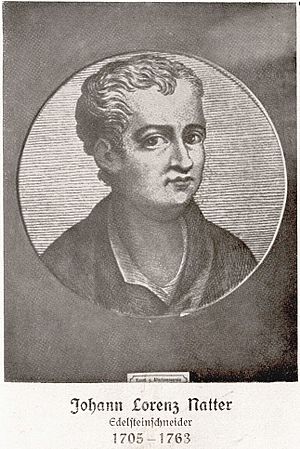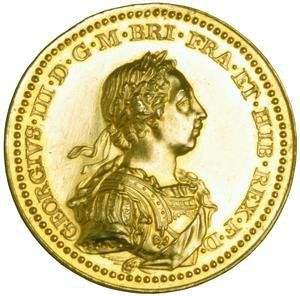Lorenz Natter facts for kids
Johann Lorenz Natter (1705–1763) was a talented German artist. He was famous for engraving beautiful designs onto precious stones. He also made special medals.
A Life of Art and Travel
Lorenz Natter was born on March 21, 1705. This was in a place called Biberach an der Riss in Germany. He started his career as a jeweller for six years. After that, he worked in Switzerland for the same amount of time. He learned a lot from a seal-cutter named Johann Rudolph Ochs in Berne.
Later, Lorenz traveled to Italy to study more. In Venice, he began learning how to engrave gems. When he arrived in Rome, he copied famous ancient artworks. He even put fake old names on some of his copies. People bought these engraved stones from him. In Florence, he worked for Baron Philipp von Stosch.
Around 1741, Natter came to England. He brought many old gems and casts with him. In 1743, he visited Denmark, Sweden, and St. Petersburg with a friend. The King of Denmark, Christian VI of Denmark, gave him a room in his palace. Natter worked there for almost a year. He was paid well and received a gold medal from the king.
He returned to England around 1754. He stayed there until 1762. He became a member of important groups. These included the Society of Antiquaries of London in 1755. He also joined the Royal Society in 1757.
Natter worked at the English Royal Mint for a short time. This was at the start of King George III's rule. In the summer of 1762, Natter went to work in St. Petersburg. He sadly died there in late 1763 from asthma.
His Artistic Creations
Many people praised Natter's skill as a gem-engraver. Some even called him one of the best modern artists. His first works were mostly seals with family symbols. He said he was always happy to copy old gems. But he promised never to sell his copies as real ancient pieces. He often signed his work. His usual signature on gems was NATTEP or NATTHP. He also used YΔROΣ or YΔROY. This was a Greek translation of the German word for "water-snake," which was "natter."
From 1732 to 1735, Natter worked in Florence. His supporter was Gian Gastone de' Medici, Grand Duke of Tuscany. For him, Natter made a portrait of the Grand Duke. He also made one of Cardinal Alessandro Albani. In 1733, he made a portrait medal of Charles Sackville, Earl of Middlesex.
Natter also had important supporters in the Netherlands. These included William IV of Orange and his family. He made special portraits for them. These were called intaglio (carved inwards) and portrait-medals.
During his time in England, the royal family supported Natter. In 1741, he made a medal called "Tribute to George II." He also had help from Sir Edward Walpole and Thomas Hollis. He engraved seals with the head of Sir Robert Walpole. He also made a medal of Walpole. For Hollis, Natter engraved a seal with the head of Britannia. He also made a cameo (carved outwards) of "Britannia Victrix."
Books by Natter
In 1754, Natter published a book in London. It was called A Treatise on the Ancient Method of Engraving on Precious Stones compared with the Modern. It was also published in French. In this book, Natter gave tips on gem-engraving. He told new artists to copy old artworks. This book helped his reputation a lot.
Natter also worked for important families like the Dukes of Devonshire and Marlborough. For George Spencer, 4th Duke of Marlborough, he made a list of gems. This list was published in 1761. It was called Catalogue des pierres gravées tant en relief qu'en creux de Mylord Comte de Bessborough.



